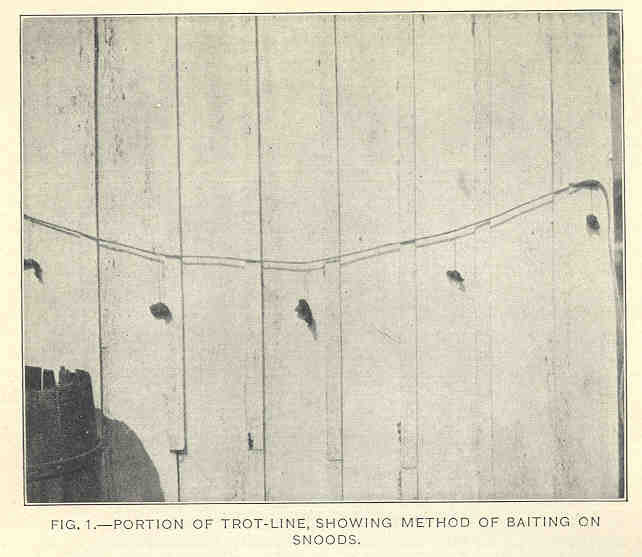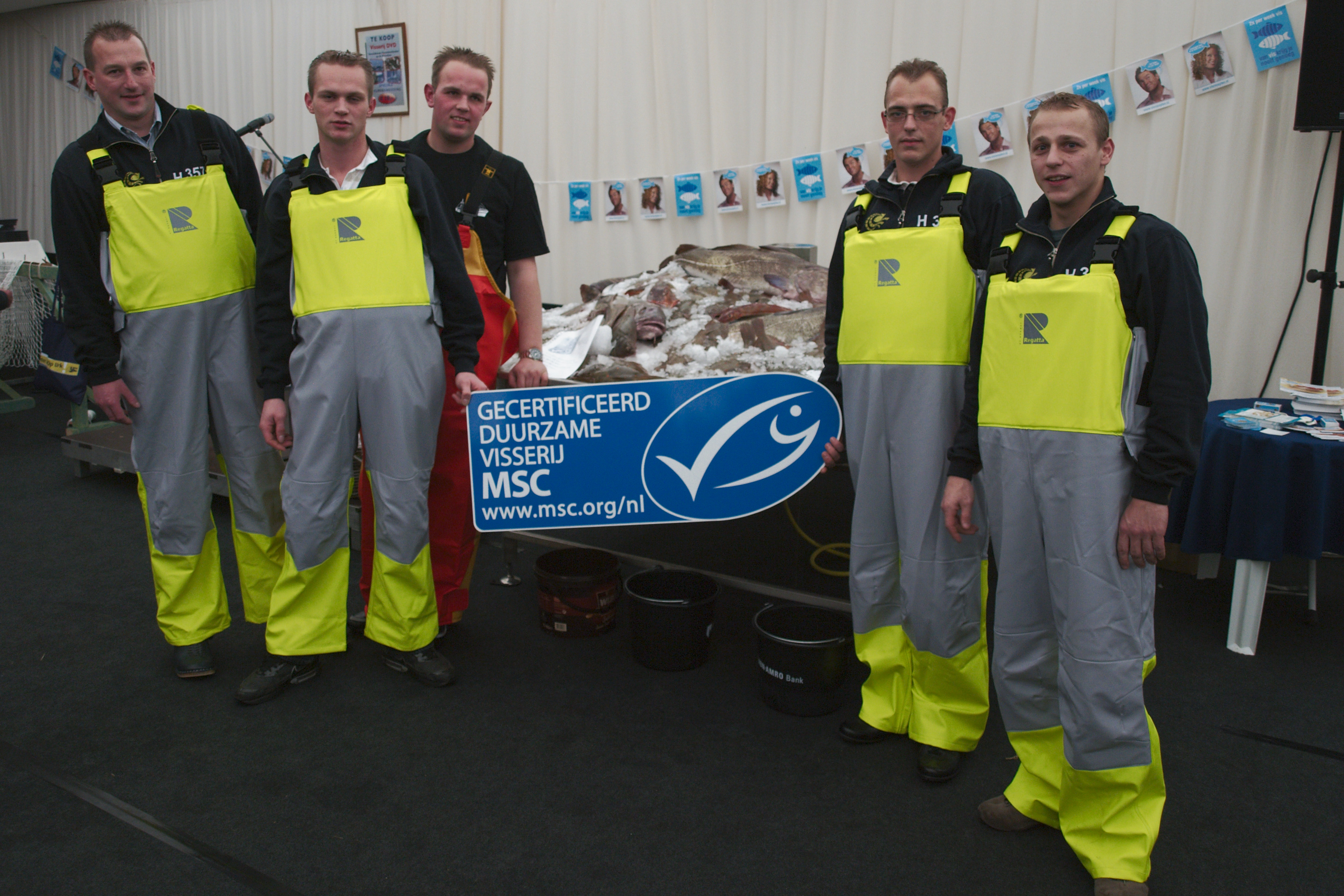|
Trotline
A trotline is a heavy fishing line with shorter, baited branch lines commonly referred to as ''snoods'' suspending down at intervals using clips or swivels, with a hook at the free end of each snood. Trotlines are used in commercial angling and can be set up across a channel, river, or stream to cover an entire span of water. There are many ways to set a trotline, with most methods involving weights at the end of snoods to keep them neatly below the water surface. They are used for catching crabs or fish (particularly catfish). Trotlines should be used with caution as they are deemed illegal in many locations. Trotlines are similar to a longline, but longlines are fixed to a surface vessel at only one end and usually towed along the water, while trotlines are fixed (usually stationarily) to the surface at both ends via anchored boats, buoys or structures. It is also contrasted with droplines, as a trotline's mainline is laid horizontally across water with a series of vertical ... [...More Info...] [...Related Items...] OR: [Wikipedia] [Google] [Baidu] |
Callinectes Sapidus
''Callinectes sapidus'' (from the Ancient Greek ,"beautiful" + , "swimmer", and Latin , "savory"), the blue crab, Atlantic blue crab, or regionally as the Chesapeake blue crab, is a species of crab native to the waters of the western Atlantic Ocean and the Gulf of Mexico, and introduced internationally. ''C. sapidus'' is of considerable culinary and economic importance in the United States, particularly in Louisiana, the Carolinas, the Chesapeake Bay, Delaware, and New Jersey. It is the Maryland state crustacean and the state's largest commercial fishery. Due to overfishing and environmental pressures some of the fisheries have seen declining yields, especially in the Chesapeake Bay fishery. Unlike other fisheries affected by climate change, blue crab is expected to do well; warming causes better breeding conditions, more survivable winters, and a greater range of habitable areas in the Atlantic coast. Whether this will have negative effects on the surrounding ecosystems ... [...More Info...] [...Related Items...] OR: [Wikipedia] [Google] [Baidu] |
Dropline
A dropline is a commercial fishing rig consisting of a long fishing line set vertically down into the water, with a series of baited hooks attached to the ends of side-branching secondary lines called ''snoods''. Dropline fishing, or droplining, is a specialized angling technique. Droplines may be set either down underwater trenches or just into the open water column. They have a weight at the bottom of the line and are fixed to the water surface at least one float at the top. They are usually not as long as longlines and have fewer hooks. Droplines can be contrasted with trotlines. Whereas a dropline has a series of hooks suspended sideways off a vertical mainline, a trotline has a series of hooks suspended vertically off a horizontal mainline. Conservation impacts A concern for marine conservation is that droplines are able to access areas that are otherwise natural fish refuges, such as deep sea canyons and seamounts.Australia's Sustainable Seafood Guide: Expanded Editi ... [...More Info...] [...Related Items...] OR: [Wikipedia] [Google] [Baidu] |
Catfish
Catfish (or catfishes; order Siluriformes or Nematognathi) are a diverse group of ray-finned fish. Named for their prominent barbels, which resemble a cat's whiskers, catfish range in size and behavior from the three largest species alive, the Mekong giant catfish from Southeast Asia, the wels catfish of Eurasia, and the piraíba of South America, to detritivores (species that eat dead material on the bottom), and even to a tiny parasitic species commonly called the candiru, ''Vandellia cirrhosa''. Neither the armour-plated types nor the naked types have scales. Despite their name, not all catfish have prominent barbels or "whiskers". Members of the Siluriformes order are defined by features of the skull and swimbladder. Catfish are of considerable commercial importance; many of the larger species are farmed or fished for food. Many of the smaller species, particularly the genus ''Corydoras'', are important in the aquarium hobby. Many catfish are nocturnal, [...More Info...] [...Related Items...] OR: [Wikipedia] [Google] [Baidu] |
Largemouth Bass
The largemouth bass (''Micropterus salmoides'') is a carnivorous freshwater gamefish in the Centrarchidae ( sunfish) family, a species of black bass native to the eastern and central United States, southeastern Canada and northern Mexico, but widely introduced elsewhere. It is known by a variety of regional names, such as the widemouth bass, bigmouth bass, black bass, bucketmouth, largies, Potter's fish, Florida bass, Florida largemouth, green bass, bucketmouth bass, Green trout, gilsdorf bass, Oswego bass, LMB, and southern largemouth and northern largemouth. The largemouth bass is the state fish of Georgia and Mississippi, and the state freshwater fish of Florida and Alabama. Taxonomy The largemouth bass was first formally described as ''Labrus salmoides'' in 1802 by the French naturalist Bernard Germain de Lacépède with the type locality given as the Carolinas. Lacépède based his description on an illustration of a specimen collected by Louis Bosc near Charleston, S ... [...More Info...] [...Related Items...] OR: [Wikipedia] [Google] [Baidu] |
Nonbuilding Structure
A nonbuilding structure, also referred to simply as a structure, refers to any body or system of connected parts used to support a load that was not designed for continuous human occupancy. The term is used by architects, structural engineers, and mechanical engineers to distinctly identify built structures that are not buildings. Examples * Aerial lift pylon * Aqueduct * Avalanche dam * BarriersPrasad, Deo K.. ''Designing with solar power: a source book for building integrated photovoltaics (BiPV''). Mulgrave, Vic.: Images ;, 2005. Print. * Blast furnaces * Boat lifts * Brick kilns * Bridges and bridge-like structures ( aqueducts, overpasses, trestles, viaducts, etc.) * Bus stops * Canal * Carport * Chimneys and flue-gas stacks * Coke ovens * Communications tower * Conservatory * Covered bridges Kunreuther, Howard, and Richard J. Roth. Paying the price the status and role of insurance against natural disasters in the United States. Washington, D.C.: Joseph Henr ... [...More Info...] [...Related Items...] OR: [Wikipedia] [Google] [Baidu] |
Buoy
A buoy () is a floating device that can have many purposes. It can be anchored (stationary) or allowed to drift with ocean currents. Types Navigational buoys * Race course marker buoys are used for buoy racing, the most prevalent form of yacht racing and power boat racing. They delimit the course and must be passed to a specified side. They are also used in underwater orienteering competitions. * Emergency wreck buoys provide a clear and unambiguous means of temporarily marking new wrecks, typically for the first 24–72 hours. They are coloured in an equal number of blue and yellow vertical stripes and fitted with an alternating blue and yellow flashing light. They were implemented following collisions in the Dover Strait in 2002 when vessels struck the new wreck of the . * Ice marking buoys mark holes in frozen lakes and rivers so snowmobiles do not drive over the holes. * Large Navigational Buoys (LNB, or Lanby buoys) are automatic buoys over 10 m high equipped with ... [...More Info...] [...Related Items...] OR: [Wikipedia] [Google] [Baidu] |
Boat
A boat is a watercraft of a large range of types and sizes, but generally smaller than a ship, which is distinguished by its larger size, shape, cargo or passenger capacity, or its ability to carry boats. Small boats are typically found on inland waterways such as rivers and lakes, or in protected coastal areas. However, some boats, such as the whaleboat, were intended for use in an offshore environment. In modern naval terms, a boat is a vessel small enough to be carried aboard a ship. Boats vary in proportion and construction methods with their intended purpose, available materials, or local traditions. Canoes have been used since prehistoric times and remain in use throughout the world for transportation, fishing, and sport. Fishing boats vary widely in style partly to match local conditions. Pleasure craft used in recreational boating include ski boats, pontoon boats, and sailboats. House boats may be used for vacationing or long-term residence. Lighters are used to convey ... [...More Info...] [...Related Items...] OR: [Wikipedia] [Google] [Baidu] |
Anchor
An anchor is a device, normally made of metal , used to secure a vessel to the bed of a body of water to prevent the craft from drifting due to wind or current. The word derives from Latin ''ancora'', which itself comes from the Greek ἄγκυρα (ankȳra). Anchors can either be temporary or permanent. Permanent anchors are used in the creation of a mooring, and are rarely moved; a specialist service is normally needed to move or maintain them. Vessels carry one or more temporary anchors, which may be of different designs and weights. A sea anchor is a drag device, not in contact with the seabed, used to minimise drift of a vessel relative to the water. A drogue is a drag device used to slow or help steer a vessel running before a storm in a following or overtaking sea, or when crossing a bar in a breaking sea.. Overview Anchors achieve holding power either by "hooking" into the seabed, or mass, or a combination of the two. Permanent moorings use large masses (common ... [...More Info...] [...Related Items...] OR: [Wikipedia] [Google] [Baidu] |
Longliner
Longline fishing, or longlining, is a commercial fishing angling technique that uses a long ''main line'' with baited hooks attached at intervals via short branch lines called ''snoods'' or ''gangions''.Method and Apparatus for Long Line and Recreational Bait Fishing Patent application 20080202013. 28 August 2008. A snood is attached to the main line using a clip or swivel, with the hook at the other end. Longlines are classified mainly by where they are placed in the . This can be at the surface or at the bottom. Lines can also be set by means of an anchor, or left to drift. Hundreds or even thousands of baited hooks can hang from a single line. This can l ... [...More Info...] [...Related Items...] OR: [Wikipedia] [Google] [Baidu] |
Longline or ''longline'', a transport method
{{Disambiguation ...
Long line or longline may refer to: *''Long Line'', an album by Peter Wolf *Long line (topology), or Alexandroff line, a topological space *Long line (telecommunications), a transmission line in a long-distance communications network *Longline fishing, a commercial fishing technique *AT&T Long Lines, a telecommunications network *AT&T Long Lines Building, now known as 33 Thomas Street, a building in New York City *Aerial crane An aerial crane or flying crane is a helicopter used to lift heavy or awkward loads. As aerial cranes, helicopters carry loads connected to long cables or slings in order to place heavy equipment when other methods are not available or economically ... [...More Info...] [...Related Items...] OR: [Wikipedia] [Google] [Baidu] |
Illegal Fishing
Illegal, unreported and unregulated fishing (IUU) is an issue around the world. Fishing industry observers believe IUU occurs in most fisheries, and accounts for up to 30% of total catches in some important fisheries. Illegal fishing takes place when vessels or harvesters operate in violation of the laws of a fishery. This can apply to fisheries that are under the jurisdiction of a coastal state or to high seas fisheries regulated by regional fisheries management organisations (RFMO). According to the UN Food and Agriculture Organization (FAO), Fisheries and Aquaculture Department, illegal fishing has caused losses estimated at US$23 billion per year. Unreported fishing is fishing that has been unreported or misreported to the relevant national authority or RFMO, in contravention of applicable laws and regulations. Unregulated fishing generally refers to fishing by vessels without nationality, vessels flying the flag of a country not party to the RFMO governing that fishing a ... [...More Info...] [...Related Items...] OR: [Wikipedia] [Google] [Baidu] |






